Ancient Greeks: clothes, shoes and accessories. Ancient Greece Culture
The ancient Greeks erected the beauty of a healthy body in the cult. In this era of prosperity of the state it was believed that a rough physical work spoils the figure, since the same type of load musculature develops disproportionately. Clothing was designed to emphasize the harmony of the body. The main way advantageous outline silhouette served artfully arranged the folds of matter. This process is the rich people paid a lot of time.
Initially, the fabric made from the wool of sheep, then flax. Subsequently, from the East started to bring cotton. He was very expensive, and the clothes of it was affordable for only a wealthy masters.
That was a wardrobe of the ancient Greeks, we can only judge by the surviving monuments of architecture, the drawings on the walls of houses and utensils, as well as from the literary heritage.
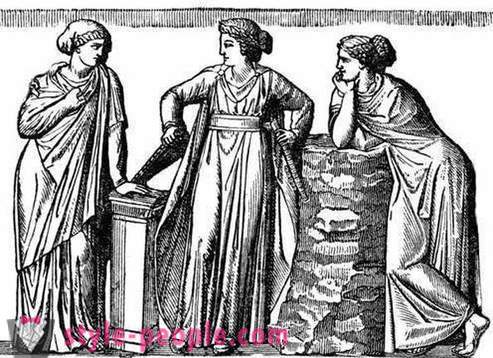
Fibulae
Fibula - a brooch or barrette. It was an indispensable accessory of clothes of the ancient Greeks. She fastened the cloth dress, as the fabric to sew was not accepted - they are freely thrown through one or both shoulders and fixed brooches.
Fibulae were made of metal and decorated with stones, pearls, nacre. They made patterns with beading, stamping or casting. fibulas size ranged from one centimeter - to bond panels of thin Ionic chiton, desyatisantimetrovyh to drive - for the bonding of male attire and ornaments of hard tissue.
By type of fibulae judged the position of the person in a society and its material resources.
Belt
Belts worn by all Greeks, except the dancers, whom he prevented to move gracefully and snare.
Greeks attached great importance to the quality and type of material used to make the belt. He could be a leather with various buckles or laces, cloth or woven from metal rings. The belt should match the color of clothes and show the status of its owner. Often around the waist tied not once, but several zones.
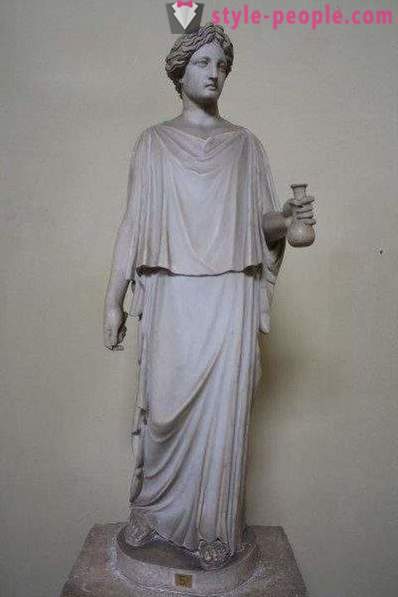
Fabrics for clothes
The material from which to make clothes of the ancient Greeks, were woven into every home. This work was carried slaves, but free women of Greece also had to be able to work on the loom.
For clothing used only the best wool - fabrics were obtained with light and beautifully draped. In the woolen clothes of thin and soft tissue in the summer is not hot, moreover, it is not sewn on the sides and allows the wind to cool the body. Casual women's clothes were made of fine linen.
Traditional drawings
As decoration on one side of the fabric can do embroidery embroidery or cross, as well as to apply the printing pattern of thin gold plates. The most traditional patterns are palmette - a stylized image of palm leaves, honeysuckle or flower acanthus kerikion - Wand of Hermes outlet - a circle of a blossoming flower, square - continuous broken line consisting of at right angles to each other segments Cretan wave, beads and network.
In such a dress pattern located on the side or top facing away parts. Hem, as a rule, do not decorate - a horizontal line at the bottom reduces the growth and distorts proportions. The vertical arrangement of the figure does rise above, and the band at the shoulders or chest visually expands that part of the body.
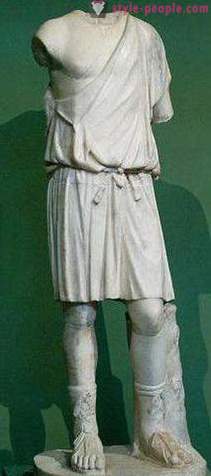
Color
The color of dress in the culture of ancient Greece had a particular importance. Clothes stained with pigments of plant and animal origin. The most prestigious is white clothes, because lighting wool and flax were long and time consuming process. In occasions the rich man dressed up in a purple robe. This pigment was extracted from the shells of mollusks nautilus. Cheaper analogue of the color obtained from the color of the madder, safflower or some lichens.
Dark green, black and gray color means mourning. Slaves also wore clothes featureless shades.
Women's costume of ancient Greece different bright shades of yellow, red and blue colors. Green, but only a light shade, it was also acceptable for everyday wear.
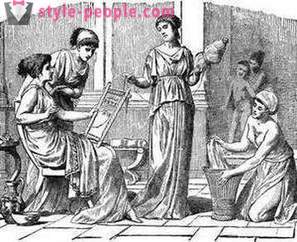
Heaton
Nowadays, under the tunic sometimes refers to any free direct silhouette dress with vertical pleats on the shoulders. This is only a likeness of the Greek chiton, which was a versatile garment for the Greeks of both sexes and all classes. Translated from the Greek word "tunic" means "clothing".
Depending on the purpose tunic varied requirements for its length, width and drape wrinkling. Gradually the original, primitive, the coat became more complex, as a result of its base there were other kinds of clothing with new names.
Warriors wore short, to the hips, coats and priests, officials and actors tragic genre - long.
The women made themselves coats average, the most advantageous for the figure, the length. The width of the material web thickness depended on the purse its owner and the fabric quality. The thinnest webs reach two meters wide. This made it possible to create very beautiful draping on the shoulders, chest and waist.
To make the figure sculpturesqueness in the corners and along the edges tunic ligated small weights (coins or flat stones). They create additional vertical lines. In this way it was possible to emphasize the convex parts of the body and hide flaws figures. Heaton is a rectangular piece of fabric, which shoulders cleave brooches, and ligated to the waist belt.
The seam was made only on the bottom of the tunic - not podvornuty hem was a sign of mourning, and denounced belonging to the lower classes.
Subsequently, the coat was regarded as the lower plateau - over began to wear trench coats and other wraps.
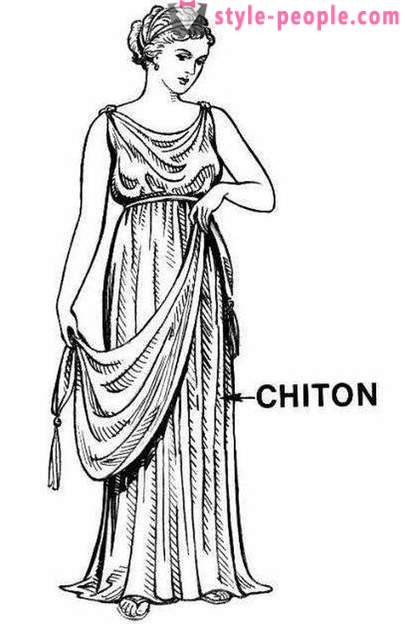
Dorian chiton
Dorian chiton - the clothes of the first period of antiquity and the progenitor of all subsequent modifications. He has long remained the only Spartan women clothing. This kind of short tunic is a piece of fabric, a 2 m-1, 8 m.
Dorian the coat is a single panel of fabric folded in half. Fold falls on the left side, and the edge of the fabric - on the right and, respectively, on the bottom and on top. Brooches fastened point on his shoulders at a distance of about 30-50 cm from each other - to his chest formed a small cascade of matter, but the fabric will not fall off the shoulders. Free piece of cloth hanging on the sides under the arms. Tied at the waist belt.
Sometimes the upper fabric edge turned away for a few tens of centimeters - then turned similarity blouses, capes or free collar type clamp.
Ionian chiton
Ionic chiton was also among the subjects of women's wardrobe. He appeared later Dorian.
Ionic dress consisted of two fabric panels. Their width minimum length was two arm to the wrist and shoulder width. Length dependent on the woman's growth. Ionic chiton was below the knees. It was worn with a belt, making a great lap. Also, the upper edge, 50-70 centimeters, sometimes unbent. In any case, the cut length into two webs of the tunic should be about 4 meters and width - of about 2 m. Cloth tunic from the shoulders to the elbows fastened brooches. These barrettes fabric gathered pleats - is a beautiful draperies, especially if the fabric is thin enough. Tied at the waist belt decorated with gold thread and tassels.
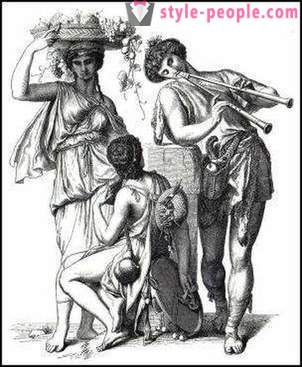
peplos, hlayna and diplaks
Peplos - Clothing Greek women. It was worn over the tunic. peplos length of slightly more than the length of the chiton. The fabric is coarser and has a rim on the sides and top edge, the color is more intense and deep. Appointment peplos not only to protect against the weather - it was used as bedding for the rest, put on the bottom of the wagon was used as a curtain or valance. In some legends of goddesses peplos fastened to the masts of ships as sails.
Hlayna - shortened peplos. It is an equilateral rectangle and lets you see the lower tunic. Hlayna draped in the likeness of the Dorian chiton, but worn without a belt.
In cold weather, the women cover themselves in diplaks - big woolen shawl. They covered her head like a hood.
Gimatov
Costume Ancient Greece is impossible to imagine without the himation. This men's coat, worn over a tunic. Himation never fastened with brooches, and laid deep folds on his shoulders. This is done by specially trained slaves. Himation suggested scant movement and weak gestures. Disintegrated during a conversation folds indicate poor education of the speaker and were a sign of bad taste. To himation tightly held on the shoulders, on the edge sewn small lead rings.
Himation - a mandatory accessory of representatives of the upper class, so the appearance of the article of clothing attached great importance. Fabrics took only the most expensive and heavy, purple stained natural, hem trimmed with a wide band of gold embroidery. Width Gimatov - 1, 7 m, and the length - 4 m. One long edge sometimes made rounded.
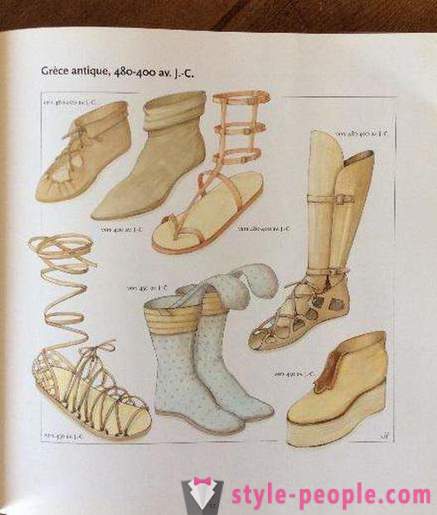
The mantle
Chlamydia, or hlamis - male cloak. Unlike himation, he is rather short and was intended for young men under 20 years old. Hlamis - an integral part of the soldiers wear. It was used also as a cape, and as bedding for sleep during rest stops.
Hlamis in shape resembles an oval or rectangle with cut corners. It throws on the shoulders and fastened a large fibula on his chest. In another case - passed under his arm, left arm, and fastened on the right shoulder, leaving the right hand free.
Throughout hlamis become worn after the coat moved to the lower discharge dresses.
exomis
As an everyday home wear ancient Greeks used a short cape, tunic type, called exomis. Warriors and free citizens were exomis with several folds running from the shoulder, and fixes brooches.
In exomis it was unseemly to appear in public, since these clothes are considered to be poor wardrobe and accessory worn to work, and the culture of ancient Greece was that simple physical work aimed at the implementation of the utilitarian needs, was despised.
Peasants, artisans and slaves did exomis of sheep skins or tissues of rough textures. Both hands remain free in it, which gave scope for movement. It is often worn as a loincloth.
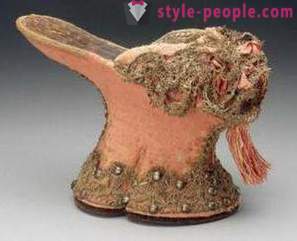
Shoes
Greek shoes featuring a large variety. Only one species of female footwear scientists counted 94 type. And despite the fact that the shoes worn by the ancient inhabitants of the Pyrenees, just outside the house.
The most common were sandals karbatiny. They were a piece of thick cowhide, cut to form a foot, and having a small perimeter around the eyelets, which karbatiny firmly tied to the legs. Famous high Greek sandal, buskins, shoes were originally nobility, and then moved into the number of theater accessories. Their high cork or wooden soles made the actors more visible to spectators from the back rows.
On antique vases, you can see the gods in sandals with soles made of thick skin, with small feet on the perimeter bumpers. It endromidy. They were very comfortable, as were cut in the form of the foot. Fingers were open. Tying reached almost to his knees and was decorated with pendants.
Krepidy - also made of leather, but laced lower than endromidy.
In addition to the leather shoes, the Greeks wore soft boots made of felt. They were designed for the cold season.
Wealthy women wore low shoes, reminiscent of modern moccasins.
Hats
In ancient Greece gave the appearance of great importance. Various wreaths of laurel leaves, olive, myrtle, pine branches, ivy, celery and colors have symbolic meaning and worn in special occasions.
Hats Greeks were rare, and the slaves were never laid.
Artisans wore felt caps - Pylos, farmers leather - Kuehne and merchants stood low hat with a round or square fields - petasos. God Hermes, patron of trade, often portrayed in petasos, elastics tied under the chin.
Women are less likely than men to need hats, as most of the time spent at home, however, going on a journey, they put petasos. If necessary, go out in the heat of the day, they protect the head and face straw hat with a wide brim - foliyami. The rest of the head edge of the protected peplos or thin scarf - Calyptra.
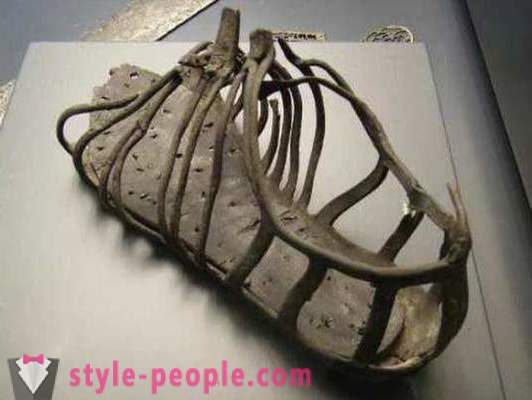
Ornaments
If we can judge only by the images and descriptions of the clothes of the ancient Greeks, the jewelry and accessories have been preserved very well. The museums of ancient art, in particular in one of the halls of the State Hermitage Museum, the collections have been found during excavations of Greek settlements.
Residents of Greece liked to adorn themselves with bracelets, rings, necklaces, earrings and garlands. They were made of gold, silver, pearls and semi-precious stones.
In Sparta to the accessories include a more utilitarian. In this area, the Greek men were forbidden to adorn themselves with anything except military armor.
The legacy of antiquity still inspires artists to create new collections of clothes and shoes. Greek costume, patterns, silhouettes and accessories not cease to amaze with beauty and grace. Great respect for the ancient craftsmanship is to carry out a very fine job, being very limited in technical means.













































